
I am pleased to report that following my post in November about the Loch Lomond and Trossachs National Park Authority’s (LLTNPA’s) unlawful application of the camping byelaws (see here), that they have started to address the issue of unlawful “No camping” within the National Park”. This post will first take a look at the law and explain why such signs are unlawful even within the camping management zones. It will then consider what progress has been made to date and what still needs to happen.
Camping and access rights
Camping is one of the activities covered by access rights under the Land Reform (Scotland) Act 2003. This means that under the law there is a right to camp, just as there is a a right to cycle, ride a horse or picnic, on any land or water where there is a right of access. The important qualifications, which were set out out in separate clauses in the Act, is that those rights need to be both exercised and managed responsibly.
The Act states that:
“a person is to be presumed to be exercising access rights responsibly if they are exercised so as not to cause unreasonable interference with any of the rights (whether access rights, rights associated with the ownership of land or any others)”.
The legal presumption here is that ANY activity covered by access rights can be carried out on any land or water included in those rights. Had the law said anything else, no go areas would have had to have been created for certain activities. This would have massively complicated what land was covered by what access rights and been very difficult to enforce. The great thing about our access legislation in Scotland, unlike the law of access law in England and Wales, is that it is mainly a matter of politeness and common sense. Generally this has worked very well. You have the legal right to picnic under a tree or stand by a gate to take a photo but not to remain under that tree when the landowner wants to fell it or to remain by the gate when the farmer wants to access their field.
Its should also be a matter for common sense that “static” recreational activities covered by access rights, such as camping, are likely to affect the rights and interests of others in different ways than “mobile” activities such as walking. Its one thing to walk or cycle by someone’s front gate, quite another to stand there for several hours with a camera in hand (which could be perceived as an invasion of privacy) or to camp there. Its partly because of this that the Scottish Outdoor Access Code contains advice on where certain activities may be appropriate and this includes advice that people should consult the owner before camping by a house.
That, however, does not mean that it would always be irresponsible to camp in such places and SNH’s guidance (see here) is clear that the right to camp legally covers exactly the same ground as other access rights. As an example, normally it would be irresponsible to camp in a farmer’s field (and who would want to do so?) but suppose you are cycle touring and have a puncture on a wet and windy night? The law doesn’t prohibit you from crossing over the nearest gate and putting up a tent for the night. I don’t believe any reasonable landowner – and what is responsible needs to be determined in part by what is reasonable – would object to this provided you got out of their way the next morning.
Coupled with the legal duty of land managers to respect access rights, what this means is that signs that say “No” to activities on ground covered by access rights are unlawful unless covered by some other legislation, including byelaws. The Land Reform Act lays a duty on access authorities to uphold access rights and this includes explicit provision to remove signs that might deter any person from exercising access rights, signs such as “No access”, “No entry”, “No camping” or “Private Keep Out”. This is why Forestry Commission Scotland’s no camping signs at Loch Morlich came down (see here).
This does not prevent Land Managers from erecting signs that try to prevent activities that are not covered by access rights. So, “no fishing without a permit” or “private road, no access for vehicles without permission” are perfectly lawful. Nor does it prevent landowners from providing advisory signs. Indeed a whole host of such signage and advice on this has been produced under the Scottish Outdoor Access Code. In the case of camping this includes “Providing information on alternative places to camp may help to spread the load to reduce cumulative impacts arising.”
So, there was nothing to prevent FCS advising people in Glen More on better places to camp and on the South Loch Earn Rd by St Fillan’s, there would have been nothing to prevent the landowner erecting a sign which said for example “Please consider others before camping here, there are good places to camp XX metres down the road”. Instead, however, they tried to ban camping entirely, whatever the circumstances.
The LLTNPA’s response to unlawful access signs
I have previously remarked on Parkswatch that while the LLTNPA Access Team generally has an excellent record in respect of upholding access rights, “No Camping Signs” provide a notable exception. Responsibility for this, I believe, lies not with the Access Team but the LLTNPA itself.
Back in 2013, under their then Convener Linda McKay, they tried to change access rights to make camping anywhere by a road unlawful. It was after they had failed to persuade the Land Reform Review Group to recommend a change in the law (see here) that they decided to extend the camping byelaws along all the main lochside roads in the National Park. Ideally, I believe, they would have liked to ban camping completely in these areas but knew they could never get away with this, hence the seasonal camping byelaws. It appears, however, that the LLTNPA Board and senior management were only happy for signs that suggested camping was banned year round to remain in place or be erected in these areas. The suspicion is the Access Team was told at some stage that dealing with “No camping signs” in these areas was not a priority – why else could it have taken so long for them to start addressing these issues?
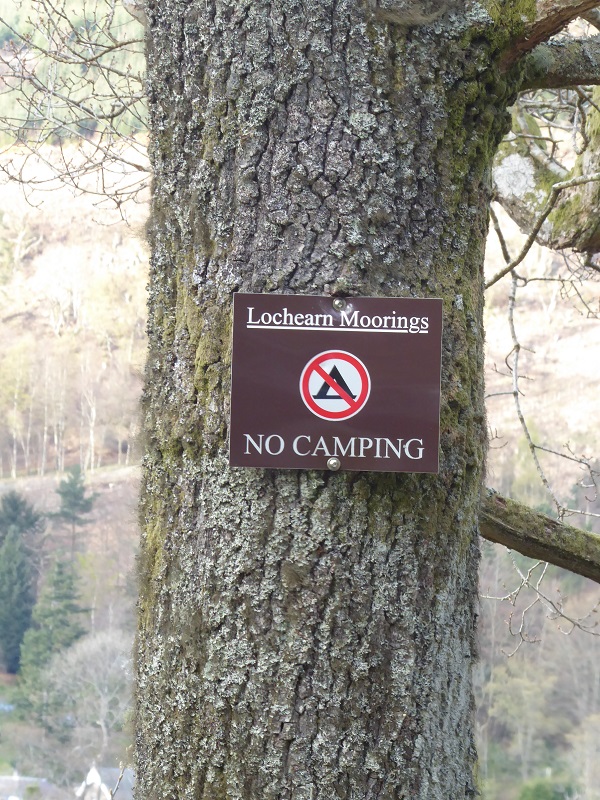

It is therefore extremely welcome that the Access Team have now started to tackle these signs. Having had no meaningful feedback about the south Loch Earn no camping signs for three and a half years, since I first reported them in May 2015, I emailed both the Access Team and the Convener of the LLTNPA, James Stuart, after my post in November. That elicited this response on 7th December:
“Dear Mr Kempe
With regards to your enquiry as to the status of the cases below, we can confirm that:
- South Loch Earn Road –this is ongoing, however the landowner has agreed to the removal of the signs at a meeting on 19th October with a deadline set for end December 2018. We have scheduled in a site visit for early January to confirm resolution of this case. A further update will be issued to you once we have formally closed the case.”
Brilliant! Well done the Access Team!
There remain, however, two further cases where work appears hardly to have begun:
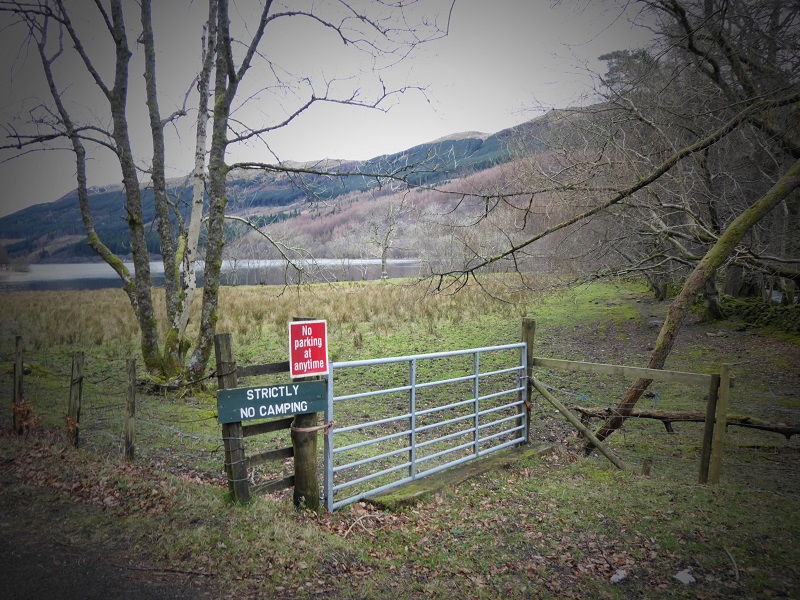
- “SW corner Loch Lubnaig –this case has yet to be investigated due to team capacity, however an initial site visit will be undertaken in late January.”
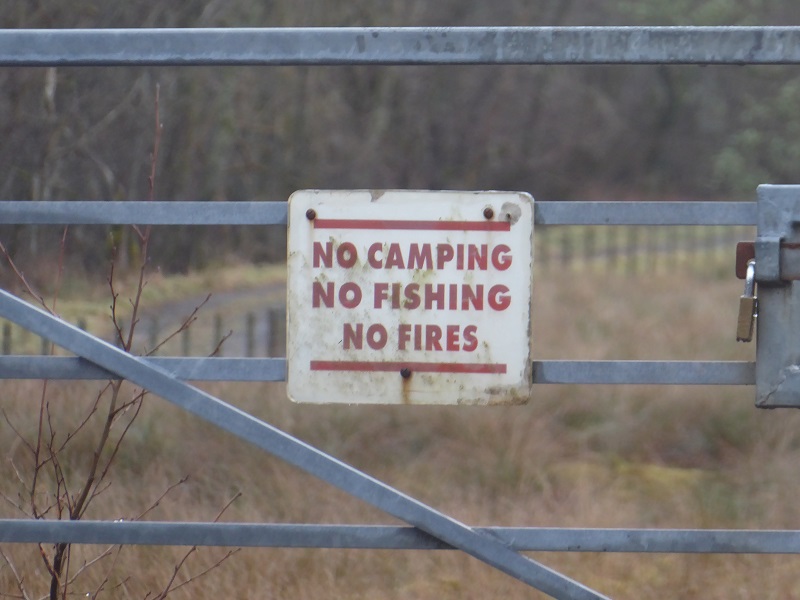
- “South of Lochearnhead – Initial investigations by the Access Advisor identified the landowner who has been contacted. No response has been received as yet and we intend to progress this in the new year.”
It was also good, however, to be informed that another unlawful access sign by Loch Earn had been removed:
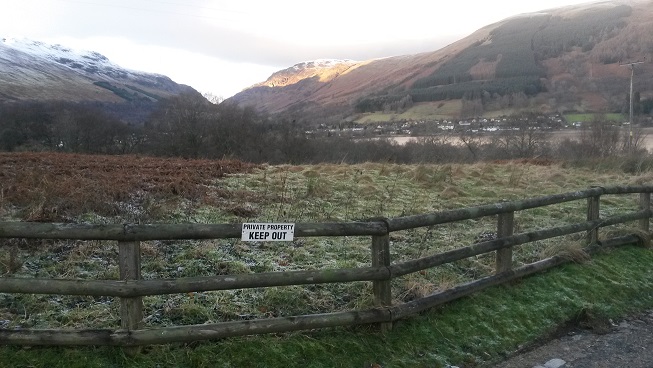
- “Edinample House–this case was closed in summer 2018 when a site inspection confirmed the sign was no longer in-situ. Please accept our apologies for not informing you of this at the time. This is not in line with our procedures and we should have notified you upon resolution”
As an aside to this, one of the findings of the LLTNPA’s Access Audit published in December was that:
Staff in the Access and Recreation Team should be reminded of the procedures for dealing with complaints and enquiries in particular they should be reminded of the requirement to save documentation in the relevant case file and to advise the complainant of the outcome of the complaint investigation.
Edinample House appears to have been one such case. Before attributing too much responsibility to the Access Team for this, however, its worth saying I believe the problem stems from the top: I have sent many emails to the LLTNPA Chief Executive, Gordon Watson, and other members of the Senior Management Team that remain unanswered. Time that the way they respond to correspondence from the public is audited perhaps?
What’s going wrong
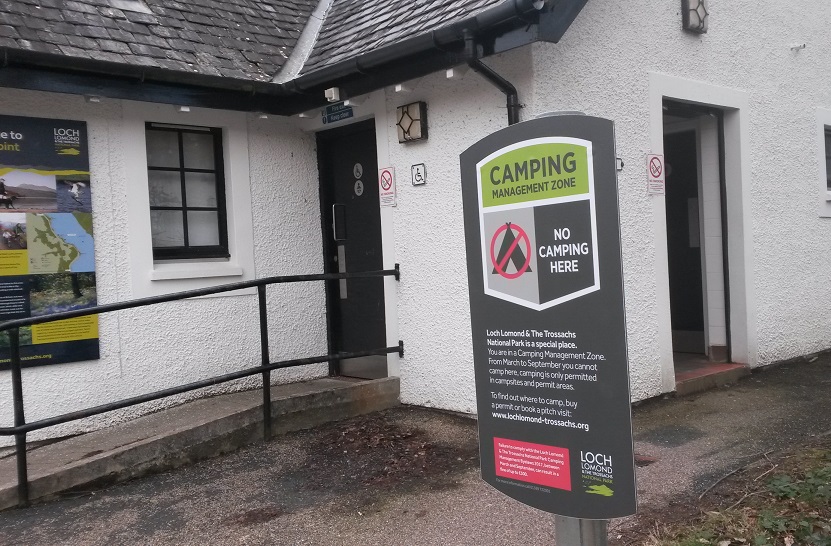
The fundamental problem is that while one small part of the LLTNPA is still dedicated to upholding access rights, most staff in the Park have been engaged in trying to undermine access rights through the development and enforcement of the camping byelaws and a wider camping ban. The so called LLTNPA camping byelaw “repeater” sign above illustrates this. Unless you are very close up you would think that camping was not allowed here at all times (although quite why anyone would want to camp by the toilet block in brambles is hard to understand!)
The qualification on the bottom half of the sign is unreadable from any distance. The effect of these signs, which the Park has been busily installing (at what cost?) within the camping management zones, is to give the impression to the passer by that camping is not allowed in these places at any time. That is wrong. Either the LLTNPA needs to remove these signs, like the signs that say “deer stalking in progress”, at the end of each “camping season” or they need to change the sign completely so its clear to the casual observer that camping is still perfectly lawful for five months of the year.
Its a mite hyprocritical for the LLTNPA to require landowners to remove unlawful “no camping” signs when its busy putting up such signs itself. Unfortunately, its unlikely the Access Team would ever be allowed to address this issue and therefore it needs to be taken up in the National Access Forum.
While it appears the Access Team are now tackling other “No Camping Signs”, their correspondence refers to a lack of resources to do so. This is not the Team’s responsibility but is that of the LLTNPA, who have plenty of other resources available.
This is illustrated by the Park’s Rangers passing the unlawful access signs featured here on a daily basis through the camping byelaw “season” but doing absolutely nothing about them.. Until I reported them, these signs were NOT logged as access problems. It appears that either the Ranger Service is too ill-informed about access rights to help uphold the law or that they have been instructed that this is not their job. Whatever the explanation, this is wrong and needs to be put right (for example through training). Its also a complete waste of resources. Instead of the Access Team, for example, having to go out and check whether the south Loch Earn no camping signs have come down (as they said they would do in January), why can’t the Ranger Service do this for them?
That, however, would mean the LLTNPA taking a joined up approach to access, something which they have for some time appeared incapable of delivering. Perhaps the new Members of the Board can rise to the challenge?

So does this mean I can camp on south lochearn without booking in line thanks
I am afraid this hasn’t changed the camping byelaws Thomas, what has happened however is that signs which suggested you could not camp OUTWITH the camping byelaw “season” have come down. While the Park is trying to get everyone to book online in advance, in practice if you turn up to a permit area and agree to purchase a permit if questioned by a Ranger that should not result in a referral for prosecution. The risk is though they may claim the permit area is full and ask you to move on somewhere else.
Most people only go hikeing and camping in good dry days sunny days so this booking on line and in advance is not for them also a lot of people can not do or will not do on line and on line banking and many people don’t use 500 pound smartphones or even take a mobile phone with them If I am kayaking and it dark in a few hour’s I camp I don’t want a camp site .If someone is walking the west highland way and it’s getting dark they camp If I driving and I pull into laybys at night I seeping in my car that’s why laybys are their for people’s safety England put laybys their for people’s safety In Scotland they put hug rocks blocking laybys .Most kids who go camping don’t have much money or experience of hikeing and camping are put off first time and this no camping in loch lomond is shameful and before someone go’s on about rubbish in this day and age wee have binoculars night vision hiding camera’s ribboats police rangers. The camp sites are fine if you want that but why are the rangers only their to lock up at night and check you payed money WHY are they not showing bush crafts doing campfire nights talking and learning kids
Is there any reason that as a concerned and informed citizen that you couldn’t take down the sign?
You need to be very careful about this as if you damaged a sign when taking it down you could be charged with criminal damage and if you remove it with theft. An alternative is to cover an unlawful sign up with sticky tape – eg I have seen this happen to the “No” in no camping signs – and then get someone to report it to the access authority who have legal powers to deal with the sign more permanently.